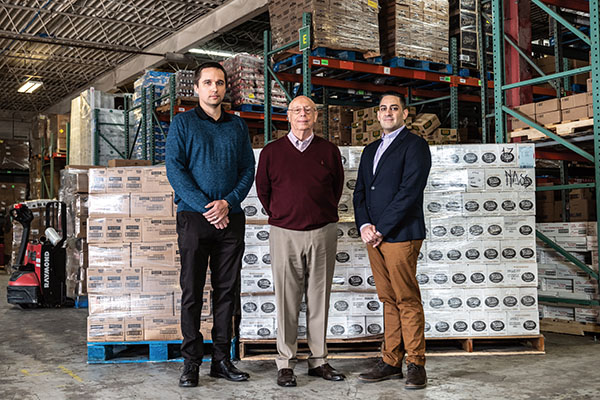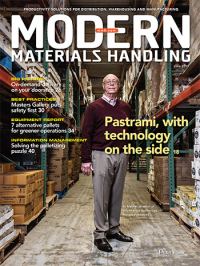Pastrami, with technology on the side
After 30 years of paper-based distribution, Nassau Provisions implemented a WMS to distribute specialty and kosher foods from its 80,000-square-foot distribution center.
Given the amount of coverage that publications like Modern give to warehouse management systems, or WMS, you’d think they’re as ubiquitous as water coolers and time clocks. In truth, some 35% of distribution centers are not using a WMS—and 6% say they have no plans to implement one—and nearly a fourth are not using bar code scanning. That means that even some facilities that have implemented a WMS are still directing their associates by paper. That’s according to a recent article in Supply Chain Management Review by the team that conducts an annual DC Measures Study.
In Freeport, N.Y., Nassau Provisions Kosher Foods Inc. (NPKF), a nearly 40-year-old distributor of fresh, refrigerated and frozen foods, realized paper-based order fulfillment would no longer cut the mustard. If the company was going to realize its vision to become the leader in kosher and specialty food distribution, it needed to implement a WMS (WMS, HighJump Software; system integration, Front Line Systems) and bar code scanning.
“For years, the prevailing operational philosophy was to get the job done any way possible to serve the customer,” says Al Maurer, the director of information technology. “As the size of operations grew, that approach was hindering growth. Inventory was inaccurate and often in the wrong location; data was unavailable to manage a growing workforce; our costs were escalating; and accurate and timely deliveries were beginning to be a problem.”
In June 2018, Maurer was brought on to lead a WMS selection and implementation project, including the development of an IT support team. Eight weeks after the system went live this past February, the WMS was already delivering benefits, such as improved inventory accuracy, more efficient workflows and a generally less chaotic working environment.

A WMS brought a greater level of inventory control and accuracy to Nassau Provisions.
“Passover is our peak season, and it can get chaotic,” says Maurer. “This year, there was no chaos or confusion. It was just more of the same of what we now do every day.” A key to that success, he adds, was putting in quality control checks that ensure associates are in compliance with processes and procedures. Think of it as pastrami—and matzo, chopped liver, halloumi cheese and kosher beef hot dogs—with a side of technology.
The process that the Nassau Provision team employed to research the market, select a WMS provider, implement the system in conjunction with a system integrator, and create a support team can serve as a model to other small to mid-sized companies on the same journey.
Leading specialty food distribution
NPKF was established in 1982 to distribute kosher, specialty and general groceries to kosher delicatessens in the Tri-State area of New York, New Jersey and Connecticut. While the delicatessen market remains an important vertical, NPKF today sells to more than 1,600 locations, including supermarkets and restaurants, with a reach that now extends to summer camps and resorts in the Catskills and weekly deliveries to Maryland, Florida and California. The company manages and distributes more than 10,000 SKUs including frozen foods, ice cream, dairy products, meat, groceries, specialty items as well as kosher and kosher for Passover items. Frozen food accounts for at least 30% of the volume. Over the years, distribution space expanded from 15,000 to 30,000 square feet and then to the present 80,000-square-foot location on Long Island.
The business model is similar to the wine and spirits industry: Orders for next-day delivery can be placed up until 6 p.m. and fulfillment is at the case level. “Many of our customers are small restaurants and stores without sophisticated demand planning,” says Maurer. “When they call, they need a delivery tomorrow.” Most of the day shift is devoted to receiving, putaway and replenishment as well as picking for Florida and California deliveries. Picking for next-day delivery begins late in the afternoon and goes into early the next morning, when trucks are loaded to serve 17 different routes.
Kosher food has two distinguishing characteristics that impact distribution, according to Maurer: First, many of the suppliers of kosher and specialty food products are small producers that lack the technology for things like labeling; second is the Passover season, which is NPKF’s version of November peak. “Kosher food is not the same as kosher for Passover,” says Maurer. “So, in the five or six weeks leading up to the season, our entire inventory has to change from non-Passover to kosher for Passover. And, since we’re closed Passover week, it all has to ship out before the holiday because anything in the warehouse on the first day of Passover is no longer shippable. Once we come back from the Passover holiday, the whole inventory changes again.”
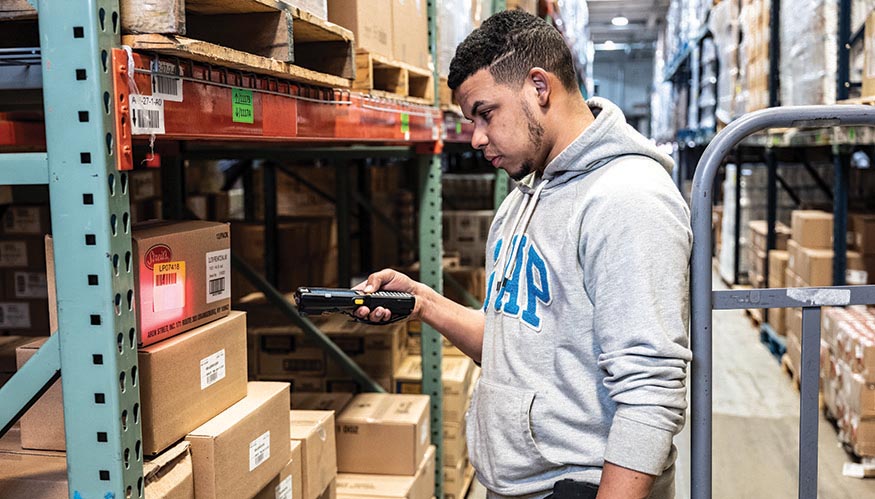
The WMS assigns scanned product to an associate until it is scanned at a new location, allowing for better tracking.
To make that happen, NPKF dedicates a portion of the warehouse just to kosher for Passover. That area has to be re-slotted before Passover, and then re-slotted again after the holiday. Adding to that challenge is that while the items are different, manufacturers use the same bar code labels for both products. That means associates can’t just scan a bar code label during say the receiving or putaway process; they must read the packaging to distinguish between the two.
As recently as the spring of 2018, inventory and orders were maintained in the company’s enterprise resource planning (ERP) system and warehouse activities were managed by paper. Over the years, associates developed their own workarounds and habits to get the job done, leading to increased costs and error rates. True inventory counts were an unknown. “Paper works if you’re a small business, but there’s always a lag before activities and inventory locations are entered into the system,” says Maurer. “When you have 80,000 square feet, it’s hard to remember where everything is, and we were having trouble providing the level of service we were known for.” He adds, “it’s a testament to the Horowitz family’s vision to become the leader in their market that they saw a need for a WMS.”
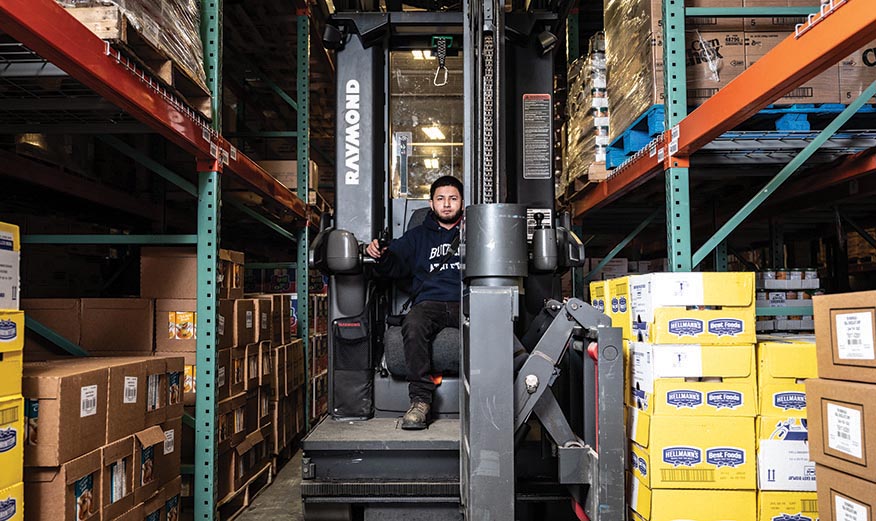
An associate stores pallets in the narrow-aisle reserve storage area.
Enter Maurer, who had his own custom WMS software system for 25 years. In June 2018, he was brought on board to select and implement a WMS with bar code scanning. In addition, Maurer was charged with developing an IT team to support the new technologies, something NPKF didn’t have at the time.
Selection
Nassau Provisions Kosher Foods’ target date to have the new WMS up and running was the end of February 2019. That would allow time to bring the associates up to speed before the changeover for Passover began. Maurer already had a list of six or seven potential solution providers from his experience in the WMS industry when he began to put together a project schedule. His first milestone was to complete selection and sign a contract by Aug. 31, 2018.
To hit that date, the next step was to create a request for information, or RFI. That involved interviews with all the relevant parties involved in warehousing and order fulfillment processes to understand the “as is” state of the operations. In addition, Maurer “trailed” sales people in the field, associates and pickers in the warehouse, and route delivery drivers to understand NPKF’s process from order to delivery.
“From interviews and trailing associates, we created a series of flow charts that outlined the functionality as we’d like to see it and the data we would need after we put a WMS in place,” says Maurer. With that step complete, he held preliminary discussions with the list of vendors he had already put together. That, along with input from NPKF’s ERP vendor (the NECS Entrée system), shortened the list to three who could meet the requirements and integrate with the ERP system.
Those conversations were followed by site visits arranged by the three remaining candidates to warehouses in the food service industry. That allowed Maurer and his budding team to see various systems in action. With those steps complete, the RFI was converted to a request for quotation (RFQ).
When the RFQ’s were returned, Maurer created a graphical analysis of the bids to see how they stacked up against four primary selection criteria:
- functionality compliance,
- cost,
- schedule compliance, and
- reputation and experience.
From there, they dug deeper into some of the details. For instance, they determined that they did not want a Cloud solution since the ERP system was hosted onsite. That eliminated one vendor. Another had a very good truck-loading and route delivery system, but wasn’t as strong on core functionality as the solution provider that was ultimately selected. “We felt there were good third-party solutions that could provide route delivery if we needed it,” Maurer says.
In the end, the deciding factor was a large customer base, including experience in food distribution, a stable platform and deep support capability. Critically important was the selection of a value-added reseller (VAR) who had the ability to add functionality that was missing, such as the ability to capture catch weights with a bar code scan. By the first week of September, NPKF had signed a contract with Front Line Systems, a value-added reseller of HighJump’s WMS. “We felt this was a system we could grow with to any level in the foreseeable future,” says Maurer.
Lessons learned
Once the contract was signed, Maurer created a detailed schedule for deployment. It included scope plans, work breakdown schedules, a finance plan, a purchasing plan and a risk-analysis plan. The team held 15-minute scrums every morning to talk through issues they would face during the day and were in constant communication with the VAR partnering on the project. Meanwhile, he also put together an IT team, including IT manager Dmitriy Arteev, inventory manager Michael Hopkins, and quality assurance manager Shay Hirji. They targeted Jan. 5, 2019, as the go-live date, four months after signing the contract.
It didn’t happen. The team was 85% of the way through the process by January 5, but still had to conduct a physical inventory of the entire warehouse, since, after all, a WMS is only as good as the information in the system, and up to that time, NPKF was not keeping an accurate inventory. But as of January, inventory in the building hadn’t been properly identified and labeled; nor was it all stored where it was supposed to be stored. The freezer was particularly difficult to count.
A second hurdle was an ingrained “get-it-done” warehouse culture. “Our associates achieved success by doing whatever they had to do to get the job done,” Maurer says. “They were used to picking by customer and if an item wasn’t in the slot they were sent to, they just got it from another slot where they knew it was stored, but without updating the system. We wanted them to pick by route and to scan every transaction.” According to Michael Hopkins, some associates just gave back the scanners.
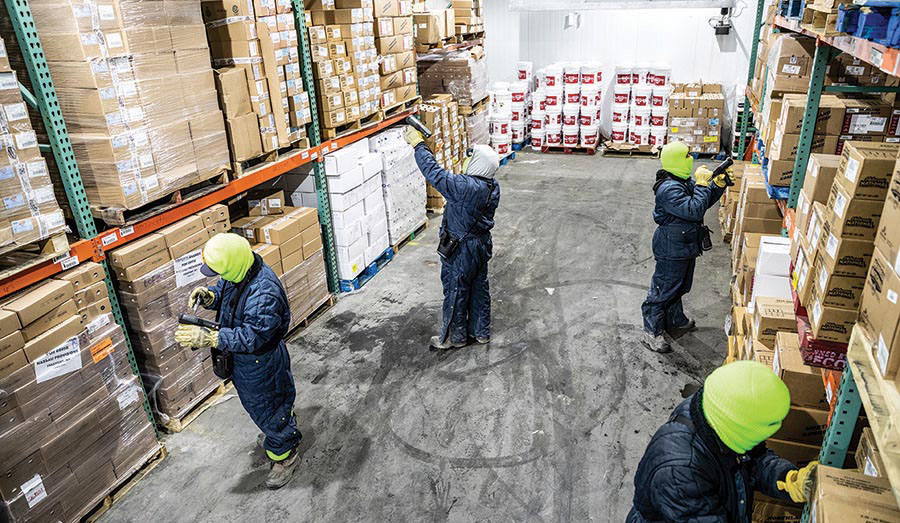
In addition to ambient temperature storage, the facility also features refrigerated storage.
Over the next six weeks, the team painstakingly validated the inventory, going from a non-existent inventory to one that was estimated at about 85% accurate. They also modified the picking process in the WMS to pick-by-customer so that it was more familiar to associates. Batch picking by route and consolidation could come later. During this validation period, they also allowed associates to pick to paper. But, they spent a considerable amount of time on training during this period to enable the transition to bar code scanning later. “We put methodologies and practices in place that kept the associates in compliance with the system,” says Hirji. “Otherwise, they would go back to what they knew how to do to get the job done.” Maurer refers to this as “using the WMS for quality control.”
One example, according to Hirji: In addition to implementing the use of license plate bar codes, now when an associate scans a pallet, it is assigned to them until it is scanned into a rack. “Essentially, the associate becomes a location until the next scan,” he says. “In the past, if a pallet was in an aisle, we wouldn’t know who put it there. Now, we know because it was assigned to an individual.” Labels are also color-coded to give a quick visual cue as to how far along an order is in the process: A green label indicates the start of an order; a yellow label is printed when the last pallet for an order is staged; and a blue label with a case count is issued when pallets are ready to be wrapped. In addition, system alerts notify a supervisor if a pallet hasn’t been put away into storage in a certain amount of time.
A second quality assurance control is something NPKF calls a skip. Early in the implementation, if an associate was sent to an empty location, they might scan the location tag on the empty spot, but then go to a location where they knew that inventory was stored and pick the order without notifying anyone. That skipped step meant the inventory data was wrong—and not likely to get corrected. “Now, we’ve put in a process that alerts a supervisor if an associate goes to an empty location,” says Hirji. Today, nothing moves without a scan.
A third is that the system can automatically capture catch weights and expiration dates by scanning serial numbers. “Associates no longer have to write anything down, which was prone to error,” says Maurer.
Last, the system was modified to generate custom reports, such as productivity reports. “We can now trace an issue back to the last person to have touched a pallet or product,” says Arteev. “If an order selector pulls 150 cases in an hour, nothing the next hour and 50 after that, we can address that to understand what’s happening that is impacting their performance.”
Maurer notes that paper-based picking was abandoned almost as soon as the system went live for the second time in mid-March. Seven weeks later, he says, NPKF is seeing dramatic results. “When we started this, inventory accuracy was an unknown,” he says. “We quickly got to 85% and we’ve improved since then, with a goal to get to 98%.” Today, he adds, “we go to the pick location, we pick it and we ship. If product isn’t there, we fix it at the storage location and in the WMS. The customer is getting the product that they ordered.”
More importantly, the Passover season went off without a hitch. “At the start, it was just more of the same,” Maurer says. “No chaos, no confusion and improved quality.”
Inside the Nassau Provisions new WMS: From paper to software
Nassau Provisions Kosher Foods Inc.
Freeport, N.Y.
Square Footage: 80,000 square feet
Products Handled: Fresh, refrigerated and frozen kosher foods
Throughput: 7,000 to 8,000 cases per day with seasonal holiday spikes, such as Passover
SKUs: 10,000
People/Shift: 3 shifts per day/6 days per week; facility is closed on Saturday
Nassau Provisions new WMS has brought a new level of efficiency and accuracy to the kosher food distributor’s operations.
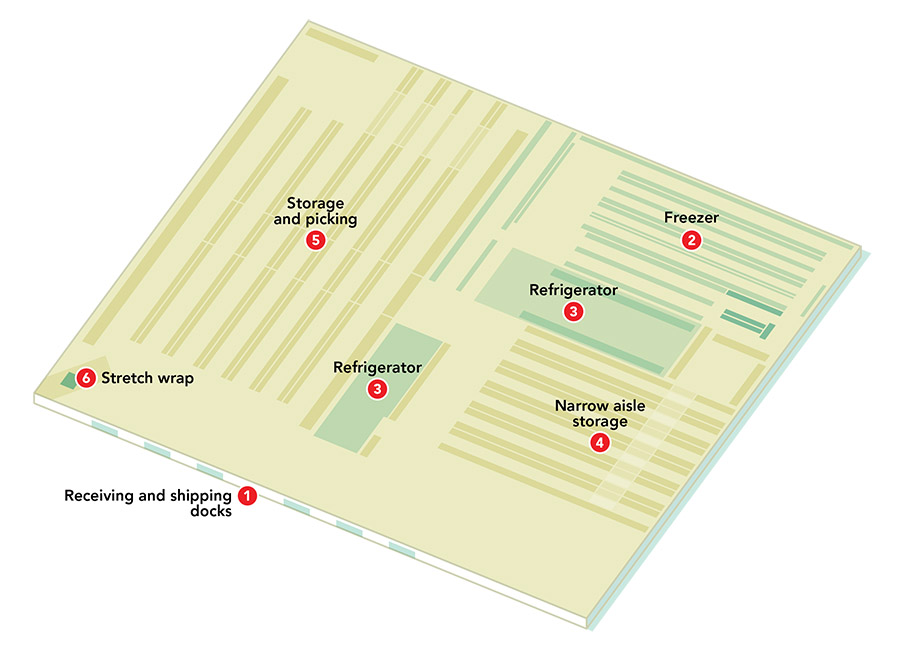
Implementing a warehouse management system (WMS) streamlined processes, improved inventory accuracy, reduced errors and positioned Nassau Provisions for growth.
Receiving: Receiving in the receiving and shipping area (1) takes place on two shifts. During the first half of the day, receiving is by appointment. During the second half of the day, the facility receives backhaul deliveries from returning route trucks. When a pallet is unloaded, a receiver scans the pallet’s license plate bar code to confirm the accuracy of the delivery and to establish a chain of custody within the system. The facility may also receive returned goods from customers, which may come back because the wrong item had been shipped or because the product had been damaged; in those instances, the system issues a credit to the customer and the product goes to a quarantine location.
Putaway: Once product has been scanned into the system and checked for accuracy, it’s ready for putaway. The system sends out alerts for frozen food (2), which takes priority so it doesn’t melt. Product may also be putaway in a refrigerated area (3); narrow-aisle storage (4); or conventional storage and picking (5). Regardless of the storage temperature, operators scan pallets or cartons into a storage location, which are now available for order fulfillment.
Picking and packing: Order fulfillment is system directed, and cases are scanned and picked to a pallet. Orders are issued by the WMS. They are also color coded to identify the different stages of the picking process: Order selectors get a green label when the order is issued; a yellow label is printed with the last pallet for an order is staged; and a blue label with a case count is issued when pallets are ready to be stretch-wrapped (6). This way, anyone on the floor knows how far along any pallet is in the fulfillment process. At present, orders are picked by customer; however, the system does have the ability to pick by zone and in the future Nassau Provisions may institute batch picking for larger orders. Associates can pick ambient temperature and refrigerated product together; frozen products are picked separately. Picked items are delivered to a staging area at shipping, where orders are consolidated, stretch wrapped and loaded onto a truck for delivery.

Article Topics
Software News & Resources
C-suite Interview with Keith Moore, CEO, AutoScheduler.AI: MODEX was a meeting place for innovation C-Suite Interview with Frank Jewell of Datex, Leading the Way in the Material Handling Industry Give your warehouse management systems (WMS) a boost Agility Robotics and Manhattan Associates partner to bring AI-powered humanoid robots into warehouses Siemens, Universal Robots, and Zivid partner to unveil smart robotic picking solution OTTO Motors showcases latest software release for optimizing floor space Rite-Hite ONE digital platform debuts More SoftwareLatest in Materials Handling
The (Not So) Secret Weapons: How Key Cabinets and Asset Management Lockers Are Changing Supply Chain Operations MODEX C-Suite Interview with Harold Vanasse: The perfect blend of automation and sustainability Consultant and industry leader John M. Hill passes on at age 86 Registration open for Pack Expo International 2024 Walmart chooses Swisslog AS/RS and software for third milk processing facility NetLogistik partners with Vuzix subsidiary Moviynt to offer mobility solutions for warehouses Materials Handling Robotics: The new world of heterogeneous robotic integration More Materials HandlingAbout the Author
Subscribe to Materials Handling Magazine

Find out what the world's most innovative companies are doing to improve productivity in their plants and distribution centers.
Start your FREE subscription today.
April 2024 Modern Materials Handling

Latest Resources


